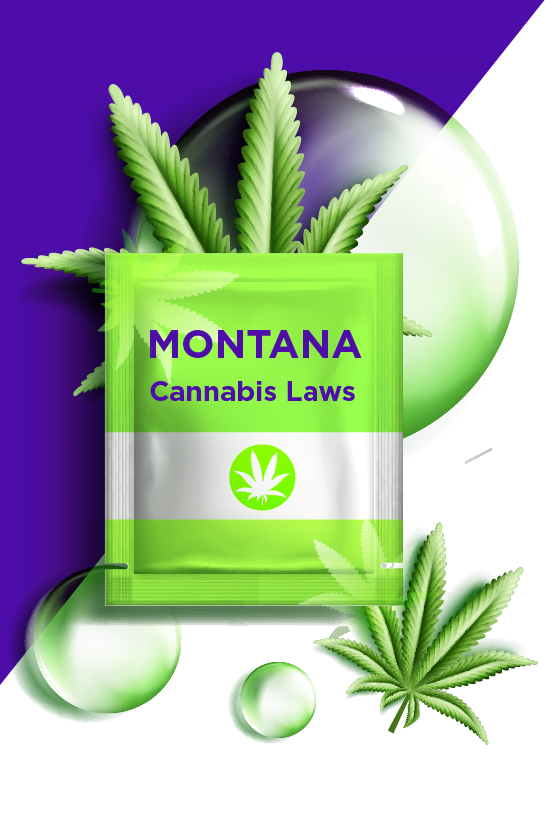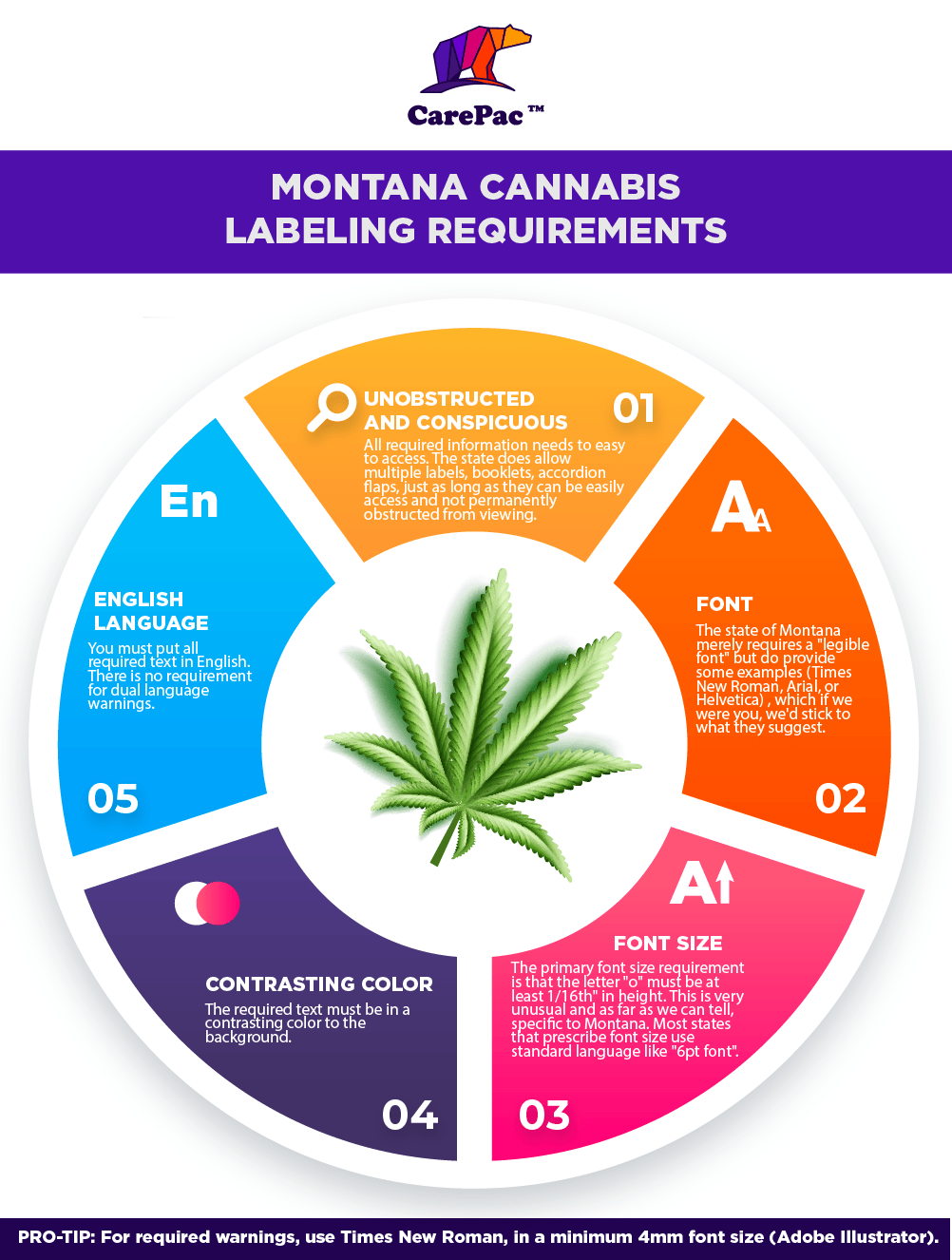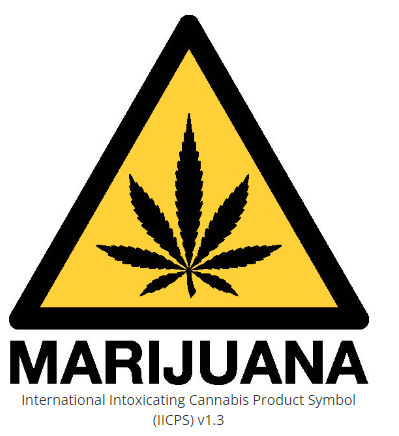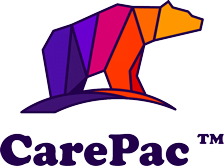No products in the cart.
Montana Cannabis Laws


Montana has a long history of legal cannabis legalization, starting in 2004 with medical. But then back-and-forth made Montana medical marijuana harder to get. In the US state of Montana, marijuana has been legal for both medical and recreational use since January 1, 2021, when Initiative 190 came into effect. Prior to the November 2020 initiative, cannabis was illegal for recreational use from 1929. Medical marijuana was legalized in 2004 in an attempt to vote. [1]
The labeling and packaging rules apply to marijuana and marijuana products that are for ultimate adult-use cannabis sales to a consumer, registered cardholder, or their designated purchasers. Please note: cannabis legalization is not currently national and this blog and the policy information in it is specific to Montana.
Montana Cannabis Laws - Marijuana Packaging Requirements
Protect: Cannabis packaging must protect the product from contamination and not impart any toxic or deleterious substances to the marijuana products. This means you should use FDA approved barrier packaging, like flexible barrier packaging.
Resealable: If the package contains more than one serving, it needs to be resealable, meaning it needs to have a recolorable zipper.
Not 'primarily' appeal to children.
You cannot include depictions (pictures, illustrations, or other graphics) of children.
Your graphics and packaging, cannot include images, drawings, or other portrayals of objects, images, celebrities, or cartoon figures that "primarily appeal to children" or are "commonly used to market products to children". This can be dicey territory, but generally avoid all cartoon characters.
Finally the state includes a subjects catch all provision that doesn't allow packaging or labeling that otherwise has special attractiveness for children beyond the general attractiveness for adults.
Use of Trademarks


The regulations prohibit trademark infringement. So unfortunately you can't be the McDowell's of Montana Cannabis. and this section is similar to several other states like Maine and Oklahoma, the state of Montana very much limits the use of trademarks or graphics that resemble trademark, or and this is a bit of a distinction between it and other states, which "bears any reasonable resemblance to" the trademarked or "characteristic packaging of any commercially available product, including but not limited to candy, snacks, baked goods, or beverages.
In this way it appears the legislative intent of this section was to prevent confusion of marijuana products with non-medicated products, and not encourage knock off marijuana versions of unmedicated products.
Exit Packaging
Montana is a exit bag state. Exit bags or exit packaging is a required for all marijuana and marijuana products at the point of sale. This means that at the point of purchase all marijuana products have to be put in "exit packaging" which is:
- Child Resistant
- Opaque
- Includes required warnings.
Child Resistant Standard in Montana
In the state of Montana the child resistant standard is found in ARM 42.39.102(8). The standard of child resistance is defined by reference to the Federal Consumer Product Safety Commission (CPSC) and 16 CFR 1700.20.
Labeling Requirements for Legal Marijuana
The general labeling requirements for Marijuana products in Montana are found in ARM 42.39.314. These basic requirements are in addition to specific requirements that are set for Flower[2], Edibles[3], Topicals[4], and Concentrates and extracts[5].


PRO-TIP: For required warnings, use Times New Roman, in a minimum 4mm font size (Adobe Illustrator).
Required State Information List
- Strain Name: They don't state how specific you must be with the strain.
- Common name: This is an interesting one, they want the package to include the "common" name for the product, so what the laws refer to as ingestible Marijuana-Infused Products" you must include "edible" or Marijuana cookie on the package as applicable.
- Names: of the dispensary, and license number of the cultivator, manufacturer.
- ID Number: ID number from the seed to sale tracking system.
- Date: Harvested, or manufactured.
- Net Quantity: They are very specific on weight / net content, it must be stated first in "U.S. Customary" and also Metric (SI) units with the metric in parentheses. For example. 1/2OZ (28g).
- If Solid or Semi Solid: Net quantity is expressed by weight, and must be prefaced with "Net Weight", or "Net".
- If Liquid: use fluid measure and include the preface "Net Contents" or Net".
- Number of Servings: You must also include the number of servings.
- Testing Statement: ""This product has been tested and meets the requirements of the state of Montana."
- QR Code: QR Code must link to the products certificate of analysis, and statement telling the user they can scan code for "additional product information"
PRO-TIP: Here is an example of a good net weight statement.
Net Weight: 2 oz. (56.7 g) (10 cookies));
Montana's Universal Marijuana Symbol


Ah yes, the ever-present "universal symbol" which as we have discussed before, is anything by universal... In the case of the state of Montana though, they did op for the International Intoxicating Cannabis Products Symbol (IICPS) which is a step in the right direction towards "universal".
The state requires the symbol will be at a minimum .33" x.33" in size.
Below we have included press ready, vectorized copies of the three symbol versions available on the state's website.
Download the Montana Marijuana Warning Symbol Vector format.
Required Warnings Label Text
Basic Warnings:
Montana's required warning labeling for Marijuana products is found in MCA 16-12-215. And is as follows:
The format required for the Montana warning is found in MCA 16-12-208
Additional Warnings:
- "Keep out of reach of children and pets
- "This product may be addictive"
- "This product may have intoxicating effects. Do not drive while under the influence of marijuana."
Ingestible / edibles warnings
"The intoxicating effects of this product may be delayed by two or more hours."
Medical Use Warnings
If the product is for medical use card holders only, there are two additional warnings:
- "For medical use only"; and
- "This product is not approved by the U.S. Food and Drug Administration to treat, cure, or prevent any disease."Flower Specific Requirements
Each package of marijuana flower must include a marijuana fact's panel which must indicate the percentage of concertation of:
Must Include:
- Total potential psychoactive THC;
- THC;
- THCa;
- CBD; and
- CBDa
May Include:
- the percentage concentration of each additional marketed cannabinoid or terpene, if applicable[6]
Edibles Specific Requirements
Ingredient List
Edibles and other ingestible products must have an ingredient list which must include all ingredients listed.
- List all ingredients
- Use common names
- list ingredients in order of predominance by weight.
- use the word "marijuana" before the part of plant (flower, trim) or type on concentrate (oil, infused butter, etc).
- Trace, insignificant amount that doesn't serve a technical purpose, or have any functional effect does not need to be listed.
Allergen Statement
Declare the presence of all major food allergens that may be present. No specific format is required other than the use of "plain language"
Marijuana Facts Panel
The milligrams per serving size or dose of:
- THC;
- THCa;
- CBD; and
- CBDa;
The number of servings or doses per package; and For multi-serving packages, the total milligrams per package of:
- THC;
- THCa;
- CBD;
- and CBDa;
Additional Warning required for any ingestible product:
"The intoxicating effects of this product may be delayed by two or more hours."
Lotions, Patches, & non-ingestible product Specific Requirements
The requirements for non-ingestible products is substantively similar to that of ingestible products. With the exception of there is no requirement for Allergen list, or delayed effects warnings.
Extracts and Concentrate Specific Requirements
The legislation requirements for extracts and concentrates are substantively similar to that of ingestible products. Food allergen statement can be omitted if the product is not intended to be cooked with, eaten, or otherwise swallowed or digested.
Additional warning regarding delayed effects is also required. [7]
Frequently Asked Questions About State Law
Q: What is the THC limits for recreational marijuana products?
Montana's THC limits are found in 16-12-224. any product that exceeds the threshold must be labeled as "for medical use only" and "This product is not approved by the U.S. Food and Drug Administration to treat, cure, or prevent any disease."
- Flower: 1 ounce of usable marijuana. The total potential psychoactive THC of marijuana flower may not exceed 35%.
- Capsules: Maximum 100 milligrams of THC per capsule and no more than 800 milligrams of THC per package.
- Tincture; Maximum 800 milligrams of THC;
- Edible or food product:
- Single Serving maximum 10 milligrams THC
- Maximum 100 milligrams of THC per package.
- Topical product: Max concentration 6% THC and 800 milligrams of THC per package;
- Suppository or transdermal patches: Maximum 100 milligrams of THC per suppository or patch and maximum 800 milligrams of THC per package
- Maximum total for any marijuana product, no more than 800 milligrams of THC.
Q: If the marijuana product DOES NOT require heat to administer must the marijuana facts panel contain total THC or total potential psychoactive THC values?
No, these items are not required on the facts panel for non-heat products.
Q: Does Montana require the method of manufacturing and solvent used be listed on the label?
Yes, the method of manufacturing, and if chemical extraction was used, the solvent used in the manufacturing process must be listed on the label.
Q: What is the packaging is too small to fit all the required compliance information?
You can (if approved by the department) display the information in a legible font that otherwise does not meet the minimum size requirement.
Labeling and Packaging Template
Montana labeling and packaging templates can be found here.
Conclusion
States with a lot of open land, natural resources, and a fertile environment for agriculture, such as Montana. There are about 28,000 ranches and ranches in the state, each averaging 2,000 acres. Cannabis farms have sprung up all over the state over the past few years. In 2019, Montana farmers planted a total of 22,000 acres of hemp across the state, averaging half a million dollars per farm. Medical marijuana, like cannabis, is not accessible to everyone and cannot be thrown in a jar. After the plant is grown, harvested and cured, there are regulations that must be met for both packaging and labeling. If one doesn't adhere to these laws, it could result in a punishable misdemeanor, fine, or felony.
Footnotes
[1] https://www.leafly.com/learn/legalization/montana
[2] https://rules.mt.gov/gateway/RuleNo.asp?RN=42%2E39%2E315
[3] https://rules.mt.gov/gateway/RuleNo.asp?RN=42%2E39%2E316
[4] https://rules.mt.gov/gateway/RuleNo.asp?RN=42%2E39%2E317
[5] https://rules.mt.gov/gateway/RuleNo.asp?RN=42%2E39%2E318
[6] https://rules.mt.gov/gateway/RuleNo.asp?RN=42%2E39%2E315
[7] https://rules.mt.gov/gateway/RuleNo.asp?RN=42%2E39%2E318
Tags

